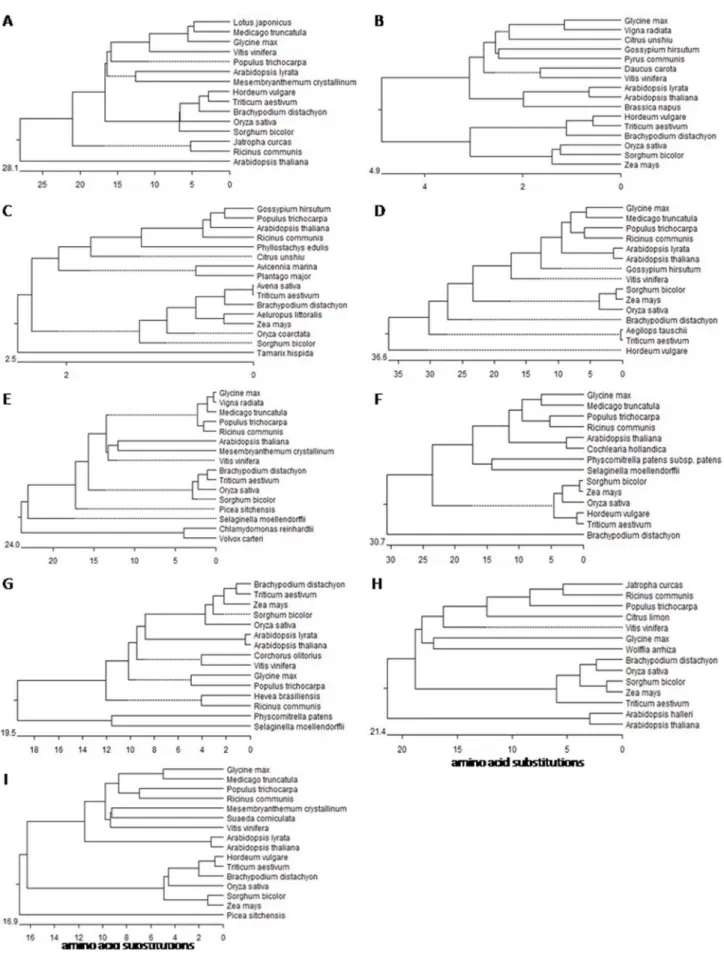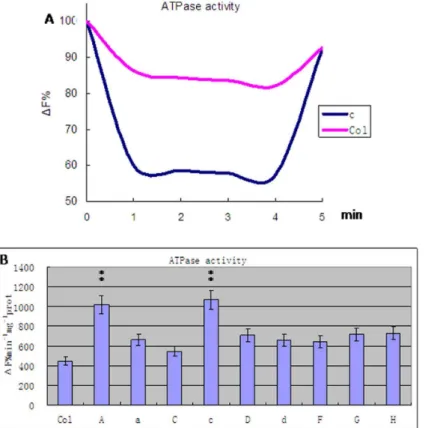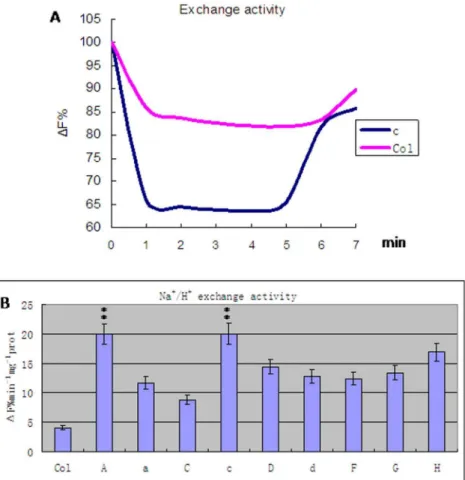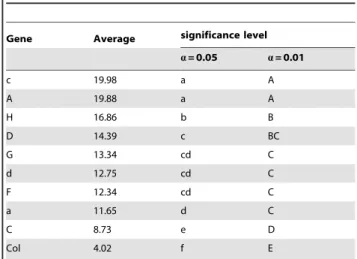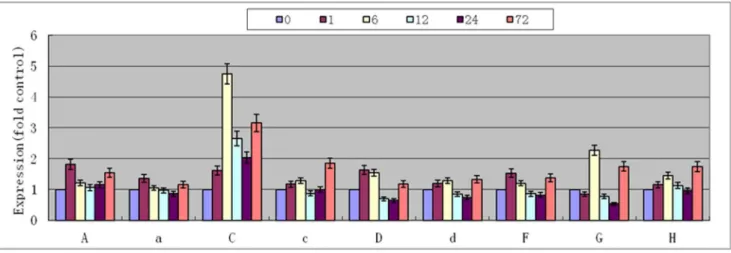Salt Tolerance in
Arabidopsis thaliana
Xiaoliang He2, Xi Huang1, Yinzhu Shen1, Zhanjing Huang1*
1College of Life Science of Hebei Normal University, Shijiazhuang, Hebei, China,2School of Biological Science and Engineering, Hebei University of Science and Technology, Shijiazhang, Hebei, China
Abstract
Genes for V-H+-ATPase subunits were identified and cloned from the salt-tolerant wheat mutant RH8706-49. Sequences of
these genes are highly conserved in plants. Overexpression of these genes in Arabidopsis thaliana improved its salt tolerance, and increased the activities of V-H+-ATPase and Na+/H+exchange, with the largest increase in plants carrying the
c subunit of V-H+-ATPase. Results from quantitative RT-PCR analysis indicated that the mRNA level of each V-H+-ATPase
subunit in theArabidopsisincreased under salt stress. Overall, our results suggest that each V-H+-ATPase subunit plays a key
role in enhancing salt tolerance in plants.
Citation:He X, Huang X, Shen Y, Huang Z (2014) Wheat V-H+-ATPase Subunit Genes Significantly Affect Salt Tolerance inArabidopsis thaliana. PLoS ONE 9(1): e86982. doi:10.1371/journal.pone.0086982
Editor:Malcolm Bennett, University of Nottingham, United Kingdom
ReceivedSeptember 1, 2013;AcceptedDecember 19, 2013;PublishedJanuary 30, 2014
Copyright:ß2014 He et al. This is an open-access article distributed under the terms of the Creative Commons Attribution License, which permits unrestricted use, distribution, and reproduction in any medium, provided the original author and source are credited.
Funding:This work was supported by National Natural Science Fund (30971766), Hebei Provincial Natural Science Fund (No.C2009000278), and Doctor Fund of Hebei University of Science and Technology (QD201046). The funders had no role in study design, data collection and analysis, decision to publish, or preparation of the manuscript.
Competing Interests:The authors have declared that no competing interests exist. * E-mail: huangzhanjing@sohu.com
Introduction
Salt stress is a major factor adversely affecting the growth of plants. It can cause an elevation of Na+
concentration in the cytoplasm, which results in osmolarity stress and ion poisoning [1]. Salt stress can also cause large reductions in yield. Thus, increasing the salt tolerance of plants is of great interest in agriculture.
H+
-ATPases are found in the plasma membrane and various endomembrane systems. They are essential for establishing the cross-vacuolar-membrane proton gradient, which promotes vac-uole Na+
compartmentalization and plant salt tolerance. There are two functional categories of H+
-ATPases. The first category of H+ -ATPases, such as F-type H+-ATPase, synthesize ATP using cross-membrane chemical potential. The second category of H+
-ATPases, such as P-type and V-type H+
-ATPases, hydrolyze ATP to generate cross-membrane proton potential. In theSuaeda salsa, enhancement of V-H+
-ATPase expression is considered to be the major mechanism for salt resistance. Enhanced V-H+
-ATPase expression provides essential energy for cross-membrane ion transport in vacuole [2]. The increased activity of V-H+-ATPase was found not to result from structural changes in this enzyme, but from an increase in its gene expression [3].
High salt concentration can increase the mRNA level of vacuolar V-H+
-ATPase [4]. In Mesembryanthemum crystallinum, salt treatment increased the transcription of A, B, E, F, c and G subunit mRNAs [5–7]. Salt-stressed and salt-adapted tobacco suspended cell culture also showed an increased level of A subunit mRNA [8]. InBeta vulgarisL. and its suspended cell culture, NaCl stimulated coordinated changes of A and c subunits [9–10]. InS. salsa(L.) Pall, salt stress increased the transcription and translation of B and c subunits [11]. SaVHAc1, LbVHA-c1 and ThVHAc1
enhance salt tolerance in transgenic plants [12–14]. We previously obtained the sequences of E and B subunits, and found that salt
treatment increased the expression of these two subunits. Overexpression of these subunits in wild-typeArabidopsis thaliana
increased salt tolerance of transgenicArabidopsis thaliana[15–16]. Here, we have cloned the other subunits besides E and B from a wheat salt-tolerant mutant (RH8706-49) using RT-PCR and overexpressed these subunits inArabidopsis thaliana to study their role in salt tolerance.
Materials and Methods
Plants
Wheat salt-tolerant mutant RH8706-49 andArabidopsis thaliana
Columbia were used in this study.
Microarray Analysis
Cloning of Wheat V-H+-ATPase Genes
Total RNA was extracted from the RH8706-49 plants at the second leaf stage. cDNA synthesis was carried out as described previously [17]. The full length cDNA sequence was obtained and primers were designed using the Primer Premier 5.0 software (Table S1).
Binary Expression Vector Construction and Transfection ofArabidopsis thaliana
The full-length cDNAs encoding V-H+
-ATPase subunits were amplified by PCR using specific primers (Table S2) and inserted into the binary vector, pCAMBIA1300, under the control of the CaMV 35S promoter. The expression vector was then introduced into Agrobacterium tumefaciens (GV3101) using the freeze-thaw method. The transformed Agrobacterium was used to transform Arabidopsis thaliana [18–20]. Transgenic Arabidopsis seeds were screened using Hygromycin (25 mg/L) that was added to the MS medium [21]. Further RT-PCR validation of the selected transgenic plants was performed (Fig. S1).
Salt Tolerance Test
After surface disinfection, seeds of the wide type and three homozygous transgenic lines were placed on MS medium that contained 0 or 70 mM NaCl and cultured in a 22uC light incubator (16 h light, 8 h dark). Root length was measured at 7 d. The plants cultured on MS media for 5 d were transferred to media containing vermiculite and cultured at 22uC (16 h light, 8 h dark), with Hoagland’s solution as a fertilizer. One week later, plants were treated with Hoagland’s solution every 4 d containing either 0 or 100 mM NaCl until 16 d. The plants were then examined.
V-H+-ATPase and Na+/H+Exchange Activity Determination
After culture for 5 d on MS, Arabidopsis thaliana plants were transplanted to potting soil containing vermiculite. After growth at 22uC for 30 days, the shoots were used for preparation of vacuolar membrane vesicles, and for V-H+
-ATPase and Na+ /H+
exchange activity tests. Vacuolar membrane vesicles were prepared as
described previously [22] with slight modification. Ten grams of plant material was ground in liquid nitrogen, mixed (1:3 W/V) with homogenizing buffer [25 mM Tris/MES, pH7.5, 250 mM sucrose, 0.5% (W/V) BSA, 10% (V/V) glycerol, 1 mM PMSF, 5 mM EGTA, 2 mM DTT, 0.6% (W/V) PVPP] and filtered with four layers of gauze. The filtrate was spun once at 480 g for 10 min. Then, the supernatant was obtained and spun once at 6,000 g for 10 min to remove the precipitate. The supernatant obtained by this centrifugation was again centrifuged at 60,000 g for 30 min, and the obtained precipitate was resuspended in suspension buffer (5 mM Tris/MES, pH 7.5, 10% glycerol, 250 mM sucrose). The suspension was then carefully overlaid on a series (8%, 25%, 40% W/V) of sucrose density gradient and spun at 70,000 g for 2 h. The component within the range of 8%– 25% in the sucrose gradient was collected for further analysis. For specific measurement of the V-H+
-ATPase activity, Na3VO4and NaN3, inhibitors of plasma membrane H+-ATPase and mito-chondrial H+-ATPase, respectively, were added to the reaction buffer [15]. The proton transport activity of H+
-ATPase was determined through acridine orange Xuorescence quenching with a Hitachi F-2500 spectroXuorometer (excitation at 490 nm, emission at 525 nm) [23]. The measuring buffer contained 10 mM MES/Tris (pH 7.5), 250 mM sorbitol, 5mM acridine orange, 50 mM KCl, 3 mM MgSO4 and 20mg of membrane protein. The reaction was initiated by the addition of 3 mM ATP. The Na+
/H+
exchange activity was inferred from the Na+ -induced dissipation of a preformed pH gradient maintained by the activity of the V-H+
-ATPase. The reaction media were the same as those used for H+
transport assays. After the fluorescence quenching had reached a steady state, aliquots of the desired salt solution were added, and the initial rates of fluorescence recovery were determined during the first 15 s. Initial rates of Na+
-dependent fluorescence recovery represented the activity of Na+
/H+ antiport (expressed asD% F min21mg21protein). The selectivity of the Na+
/H+
antiport was evaluated by adding various salts to dissipate the pH gradient in vacuolar membrane vesicles.
Expression of V-H+-ATPase in Arabidopsis thaliana
Arabidopsis thaliana plants grown for 30 d were treated with 170 mM NaCl for 0, 1, 6, 12, 24 and 72 h. Then, total RNA was
Figure 1. The expression of the probe after exposure to salt stress for 0 h, 1 h, 6 h,12 h by microarray analysis in the salt-tolerant wheat mutant RH8706-49.A. CD880816; B. AK332225.
doi:10.1371/journal.pone.0086982.g001
Wheat V-H+
Figure 2. Phylogenetic trees for different V-H+-ATPase subunit genes, including wheat genes.A, subunit a; B, subunit A; C, subunit c; D,
extracted and cDNA was synthesized using the methods described above. Real-time quantitative PCR was conducted using Rotor Gene-3000 Advanced PCR equipment. The software driving the equipment is RG3000 6.0 (Corbett Research, Australia). b-actin (GenBank accession No. AB181991) was used as an internal control. PCR product was detected using SYBR Green I (Macroprobe). The primers are listed in Table S3. Amplification
and melting curve analysis were performed. Quantitative mea-surement was carried out by the comparative Ct method [24].
Results
Cloning of Wheat V-H+-ATPase Gene
Gene chip technology was used to study the overall gene expression of RH8706-49 under salt stress and to obtain
Figure 3. Phenotype of root growth in transgenic carrying A, a, C, c, D, d, F, G and H subunit and wild-typeArabidopsis thaliana plants.Seeds of transgenic (L1, L2, L3) and wild-type plants (Col) were germinated on MS agar medium containing 0 or 70 mM NaCl for 7 d. Values are the means6SD (n = 5) (Student’s t-test, P,0.05).
doi:10.1371/journal.pone.0086982.g003
Wheat V-H+
Figure 4. Phenotype of transgenic carrying A, a, C, c, D, d, F, G and H subunit and wild-typeArabidopsis thalianaplants.Seeds of transgenic (L1) and wild-type plants (Col) grown on MS medium for 5 d were transplanted into the growth media containing a mixture of vermiculite. One week later, the seedlings were watered with Hoagland’s solution containing 0 or 170 mM NaCl for 16 d.
doi:10.1371/journal.pone.0086982.g004
Figure 5. Activity of V-H+-ATPase in transgenic carrying A, a, C, c, D, d, F, G and H subunit from wheat and wild type
Arabidopsis thalianaplants(Col).A. The accumulation of protons inside the vesicles is determined through acridine orange Xuorescence quenching. B. The activity of V-H+
differential gene expression patterns for 61,215 wheat probes. The expression for one probe (gb: CD880816) is shown in Fig. 1A. After 12 h of salt stress, its expression was up to 2.2 times higher than that in the untreated control. We selected this probe and cloned the full-length cDNA sequence of the probe by RT-PCR. This gene contained 2466 bp of a complete open reading frame encoding an unknown protein (821 amino acids) and was named a subunit of V-H+-ATPases. The sequences were recorded in the GenBank database with accession numbers JN033547. We used a same method to obtain sequences D subunit of V-H+-ATPases by the probe AK332225 (Fig. 1B) and the sequences were recorded in the GenBank database with accession numbers JN107805. We
had obtained sequences for subunits A (DQ432014), c
(DQ631550), C (DQ631548), d (DQ631549), F (DQ486058), G (DQ491026) and H (DQ681104).
Phylogenetic Analysis
Phylogenetic analyses were carried out for each subunit. The results indicate that each of the subunits is very similar in sequence to its homologs in other species. The c subunit has the highest sequence conservation, followed in descending order by A, H, F, G, d, a and D. The least conserved is the C subunit (Fig. 2).
Salt Tolerance of Transgenic Plants
The salt tolerance of homozygous plants (L1, L2 and L3) carrying a V-H+-ATPase subunit transgene was tested, using wild-type plants as a control. In MS media [20] with 0 mM NaCl, transgenic plants and their wild-type counterparts showed no difference in terms of growth. In media containing 70 mM NaCl, the transgenic plants had clearly longer roots than their wild-type counterparts. Roots of transgenic plants harbouring c, A or H subunit were 2.5-fold longer than that of the controls (Student’s
Figure 6. Na+/H+antiport activity in transgenic carrying A, a, C, c, D, d, F, G and H subunit from wheat and wild type
Arabidopsis thalianaplants (Col).A. The accumulation of protons inside the vesicles is determined through acridine orange Xuorescence quenching. B. The activity of Na+
/H+
antiport activity. Values are means6SD (n = 5 independent experiments) (ANOVA test, P,0.01). doi:10.1371/journal.pone.0086982.g006
Table 1.ANOVA test results of V-H+-ATPase Activity.
Source Degrees of freedom Sum of Squares Mean Square F Value F0.05 F0.01
Gene 9 1636073.74 181785.97 40.48** 2.12 2.89
Error 40 179625.86 4490.65
Total 49 1815699.60
doi:10.1371/journal.pone.0086982.t001
Wheat V-H+
t-test, P,0.01). Roots with the C subunit were twofold longer than those in controls (Fig. 3) (Student’s t-test, P,0.05). Transgenic plants showed a better overall shape than controls, and could bloom and bear seeds normally, while the control wilted and became scorched (Fig. 4). These results suggest that V-H+
-ATPase could substantially increase the salt tolerance of the transgenic plants.
V-H+-ATPase and Na+/H+Exchange Activities
Vacuolar membrane vesicles were prepared from transgenic and wild-type plants and tested for V-H+-ATPase activities (Fig. 5, Fig. S2). The results indicate that transgenic plants had significantly higher V-H+-ATPase activities (ANOVA test, P,0.01). Plants carrying the c or A subunit exhibited activities twofold those of controls and transgenic plants with other subunits (Least significant difference test, P,0.01). Plants with the C subunit transgene exhibited the smallest increase in activity: 1.2-fold that of the controls (Least significant difference test, P,0.05). The remainder of the transgenic plants had activities 1.5-fold higher than the controls (Least significant difference test, P,0.05). Na+/H+exchange activities were tested by Na+absorption and H+exsertion (Fig. 6, Fig. S3). The initiation of H+-ATPase activity by ATP would quench fluorescence. When this quenching reached a stable level, the addition of Na+would restore fluorescence in a dose-dependent manner. The results indicate that transgenic plants had significantly higher Na+/H+exchange activities than the controls (ANOVA test, P,0.01) (Table 1). Plants with the c or A transgene had activities fourfold that of the control plants (Least significant difference test, P,0.01) (Table 2). Plants with the C subunit transgene had the smallest increase in activity, which was about twofold greater than that of the control (Least significant
difference test, P,0.01) (Table 3). Plants with another transgene had activity about threefold higher than that of the control plants (Least significant difference test, P,0.01) (Table 4).
Analysis of V-H+-ATPase Subunit Expression Mode
Quantitative analysis results showed that the expression of V-H+-ATPase subunits in Arabidopsis thaliana was increased after treatment with 170 mM NaCl. The C subunit increase was the greatest, and most sensitive to salt. After 6 h of treatment, the level of expression was 4.7-fold higher than that before the treatment (Fig. 7). Then, the expression decreased until 72 h, at which time the expression was 3.2-fold that before the experiment (Student’s t-test, P,0.01). The expressions of A, a, D and F subunits were highest after 1 h of treatment, being 1.8-, 1.3-, 1.6- and 1.5-fold that at 0 h. Thereafter, the expressions decreased. After 72 h, the expressions were 1.2- to 1.5-fold that before treatment (Student’s t-test, P,0.05). The expressions of d, G and H subunits were the highest after 6 and 72 h (Student’s t-test, P,0.05). The expression of the c subunit was the least sensitive to salt, and only increased by 1.8-fold after 72 h (Student’s t-test, P,0.05).
Discussion
Compartmentalization of Na+
in vacuoles is one of the three strategies employed by plants to increase salt resistance [25]. Compartmentalization of Na+
mainly depends on the Na+ /H+ exchange activity at the plant vacuolar membrane. This exchange is secondary active transport, which is powered by a proton gradient. V-H+
-ATPases hydrolyze ATP and pump proton into vacuoles, which forms a cross-membrane proton gradient, which in turn provides energy for Na+
compartmentalization [26].
Table 2.Least-significant different tests of V-H+-ATPase
Activity.
Gene Average significance level
a= 0.05 a= 0.01
c 1068.64 a A
A 1017.03 a A
H 729.6 b B
G 716.09 bc B
D 710 bc B
a 663.98 bc B
d 655.57 bc BC
F 643.12 c BC
C 548.16 d C
Col 447.05 e C
doi:10.1371/journal.pone.0086982.t002
Table 3.ANOVA test results of Na+/H+exchange Activity.
Source Degrees of freedom Sum of Squares Mean Square F Value F0.05 F0.01
Gene 9 1063.22 118.14 69.93** 2.12 2.89
Error 40 67.58 1.69
Total 49 1130.80
doi:10.1371/journal.pone.0086982.t003
Table 4.Least-significant different tests of Na+/H+exchange
Activity.
Gene Average significance level
a= 0.05 a= 0.01
c 19.98 a A
A 19.88 a A
H 16.86 b B
D 14.39 c BC
G 13.34 cd C
d 12.75 cd C
F 12.34 cd C
a 11.65 d C
C 8.73 e D
Col 4.02 f E
Therefore, V-H+-ATPases play an essential role in plant salt resistance. We cloned all 11 subunits of wheat V-H+
-ATPase and subjected them to further study.
We first examined the expression of each subunit in wild-type
Arabidopsis thalianaunder salt stress. The results indicated that the expression of the c subunit was not significantly altered at the beginning of salt stress, and only increased after 72 h (Fig. 7). The c subunit was the least sensitive, with delayed elevation of expression under salt stress. These findings suggest that the c subunit is a factor that limits the full enzyme activity. In addition, the sequence of the c subunit was found to be most conserved among V-H+
-ATPase (Fig. 2), which suggests that it is a limiting factor for enzyme function. The expression of the C subunit was rapidly increased under salt stress (Fig. 7), which suggests that this subunit is the most sensitive to salt stress and that it is not a limiting factor for enzyme activity. The remainder of the subunits showed various levels of elevated expression under salt stress, with peak levels occurring around 1 to 6 h, which suggests that these subunits have certain levels of sensitivity and play certain roles in enzyme functions. In order to verify these hypotheses, we made transgenic
Arabidopsis thalianafor these subunits and tested the salt tolerance of these transgenic plants. The results indicated that plants with the c subunit transgene showed the greatest increase in salt tolerance, while those containing the C subunit transgene showed the least salt tolerance, with the other transgenic plants being intermediate increases in salt tolerance (Fig. 3, 4). These observations were consistent with thehypotheses.
The results of the V-H+
-ATPase activity test further supported our hypotheses. Plants with the c subunit transgene showed the highest V-H+
-ATPase activity, those with the C subunit the lowest (Table 1, 2), with the remainder somewhere in-between (Fig. 5). These observations may be directly related to the functions of these subunits. The functional enzyme is assembled from these subunits at various proportions and each of these subunits has a different role in the assembled enzyme. The c subunit hexamer forms the V0 core as part of the ion channel, participating in the cross-membrane ion transport [27–28]. Overexpression of the c subunit may allow more proton channels to form and increase the activity of V-H+
-ATPase. The A subunit catalyzes the hydrolysis of ATP, providing energy for proton transportation. The D subunit forms the central axis of the V1 domain [29], which is necessary for ion transport and ATP hydrolysis [30]. The G subunit is a component of the V1 stalk, participating in the coupling of ATP
hydrolysis and H+transport. The C, F and H subunits participate in the stabilization of V1 and its connection with V0. The d and c subunits have close contact with each other and stabilize V0 assembly. The a subunit is the largest subunit in V-H+-ATPase and may play a role in its assembly and localization [26]. Overexpression of the A, a, D, d, F, G and H subunits contributes relatively little to the enzyme activity.
In order to understand the mechanism of salt tolerance, we examined Na+
/H+
exchange activities inArabidopsis thalianaplants carrying a transgene of one of the V-H+
-ATPase subunits, and compared these activities with those in wild-typeArabidopsis thaliana
plants (Fig. 6). The results showed that plants with the c subunit transgene had the greatest increase in Na+
/H+
exchange activity, with those with the C subunit showing the least increase, and all other subunits in-between these two extremes (Table 3, 4). These results demonstrate that the higher the V-H+-ATPase activity, the higher the cross-membrane proton gradient, which in turn produces a greater proton driving force. In turn, more Na+ is compartmentalized in vacuoles, and hence there is higher salt tolerance.
In summary, under salt stress, plant V-H+
-ATPase activities increase, which in turn increases the cross-membrane electro-chemical gradient. As a result, salt is compartmentalized in vacuoles, which ensures normal development. This is probably a very important strategy for salt tolerance in plants. Since the c subunit is the limiting factor of V-H+
-ATPase activity, its use as a transgene in plants may enable better salt tolerance to be achieved.
Supporting Information
Figure S1 Overexpression of wheat V-H+
-ATPase c subunit in transgenic plants was confirmed by RT-PCR.
(TIF)
Figure S2 Activity of V-H+-ATPase in transgenic and
wild type Arabidopsis thaliana plants (Col).
(TIF)
Figure S3 Na+
/H+
antiport activity in transgenic and wild type Arabidopsis thaliana plants (Col).
(TIF)
Table S1 Primers used in PCR.
(TIF)
Figure 7. Relative expression of V-H+-ATPase subunits in
Arabidopsis thalianaunder 170 mM NaCl stress for 0, 1, 6, 12, 24 and 72 h.
Values are means6SD (n = 5 independent experiments) (Student’s t-test, P,0.05). doi:10.1371/journal.pone.0086982.g007
Wheat V-H+
Table S2 Primers for vector construction.
(TIF)
Table S3 Primers for Real-time quantitative RT-PCR.
(TIF)
Author Contributions
Conceived and designed the experiments: X. He ZH. Performed the experiments: X. He X. Huang. Analyzed the data: X. He X. Huang. Contributed reagents/materials/analysis tools: YS. Wrote the paper: X. He X. Huang.
References
1. Zhu JK (2001) Plant salt tolerance. Trends Plant Sci (6): 66–71.
2. Iwata M, Imamura H, Stambouli E, Ikeda C, Tamakoshi M, et al. (2004) Crystal structure of a central stalk subunit C and reversible association/dissociation of vacuole-type ATPase. The Proceedings of the Natlonal Academy of Sciences of the USA 101: 59–64.
3. Wang B, Luttge U, Ratajczak R (2001) Effects of salt treatment and osmotic stress on V-ATPase and V-PPase in leaves of the halophyte Suaeda salsa. Journal of Experimental Botany 52: 2355–2365.
4. Niu X, Narasimhan ML, Salzman RA, Bressan RA, Hasegawa PM (1993) NaCl regulation of plasma membrane H+
-ATPase gene expression in a glycophyte and a halophyte. Plant physiol 103(3): 713–718.
5. Dietz KJ, Tavakoli N, Kluge C, Mimura T, Sharma SS, et al. (2001) Significance of the V-type ATPase for the adaptation to stressful growth conditions and its regulation on the molecular and biochemical level. Journal of experimental botany 52(363): 1969–1980.
6. Golldack D, Dietz KJ (2001) Salt-induced expression of the vacuolar H+ -ATPase in the common ice plant is developmentally controlled and tissue specific. Plant physiology 125: 1643–1654.
7. Lee S, Lee EJ, Yang EJ, Lee JE, Park AR, et al. (2004) Proteomic identification of annexins,calcium-dependent membrane binding proteins that mediate osmotic stress and abscisic acid signal transduction inArabidopsis. Plant Cell 16(5): 1378–1391.
8. Narasimhan ML, Binzel ML, Perez-Prat E, Chen ZT, Nelson DE, et al. (1991) NaCl regulation of tonoplast ATPase 70-Kilodalton subunit mRNA in tobacco cells. Plant Physiol 97: 562–568.
9. Kirsch M, An Z, Viereck R, Lo¨w R, Rausch T (1996) Salt stress induces an increased expression of V type H+
-ATPase in mature sugar deet leaves. Plant molecular biology 32(3): 543–547.
10. Lehr A, Kirsch M, Viereck R, Schiemann J, Rausch T (1999) cDNA and genomic cloning of sugar beet V-type H+-ATPase subunit A and c isoforms: evidence for coordinate expression during plant development and coordinate induction in response to high salinity. Plant molecular biology 39(3): 463–475. 11. Li PH, Wang ZL, Zhang H, Wang BS (2004) Clonging and expression analysis
of the B subunit of V-H+
-ATPase in leaves of halophyteSuaeda salsaunder salt stress. Acta Botanica Sinica 46(1): 93–99.
12. Baisakh N, RamanaRao MV, Rajasekaran K, Subudhi P, Janda J, et al. (2012) Enhanced salt stress tolerance of rice plants expressing a vacuolar H+
-ATPase subunit c1 (SaVHAc1) gene from the halophyte grass Spartina alterniflora Lo¨isel. Plant biotechnology journal 10(4): 453–464.
13. Xu C, Zheng L, Gao C, Wang C, Liu G, et al. (2011) Ovexpression of a vacuolar H+
-ATPase c subunit gene mediates physiological changes leading to enhanced salt tolerance in transgenic tobacco. Plant Molecular Biology Reporter 29(2): 424–430.
14. Gao C, Wang Y, Jiang B, Liu G, Yu L, et al. (2011) A novel vacuolar membrane H+
-ATPase c subunit gene (ThVHAc1) from Tamarix hispida confers tolerance to several abiotic stresses in Saccharomyces cerevisiae. Molecular biology reports 38(2): 957–963.
15. Zhao Q, Zhao YJ, Zhao BC, Ge RC, Li M, et al. (2009) Cloning and functional analysis of wheat V-H+
-ATPase subunit Genes. Plant Mol Biol 69: 33–46. 16. Wang L, He XL, Zhao YJ, Shen YZ, Huang ZJ (2011) Wheat vacuolar H+
-ATPase subunit B cloning and its involvement in salt tolerance. Planta 234: 1–7. 17. Ge RC, Chen GP, Zhao BC, Shen YZ, Huang ZJ (2007) Cloning and functional characterization of a wheat serine/threoninekinase gene (TaSTK) related to salt-resistance. Plant Sci 173: 55–60.
18. Clough SL, Bent AF (1998) Floral dip: a simplified method for Agrobacterium-mediated transformation of Arabidopsis thaliana. Plant J 16: 735–743. 19. He XL, Tian JH, Yang LX, Huang YM, Zhao BC, et al. (2012) Overexpressing
a Glycogen Synthase Kinase Gene from Wheat, TaGSK1, Enhances Salt Tolerance in TransgenicArabidopsis. Plant Mol Biol Rep 30: 807–816. 20. Hou XN, Liang YZ, He XL, Shen YZ, Huang ZJ (2013) A novel ABA
responsiveTaSRHPgene from wheat contributes to enhanced resistance to salt stress inArabidopsis thaliana.Plant Mol Biol Rep 31: 791–801.
21. Murashige T, Skoog F (1962) A revised medium for rapid growth and bioassays with tobacco tissue cultures. Physiol Plant 15: 473–497.
22. Ward JM, Sze H (1992) Proton transport activity of the purified vacuolar H+ -ATPase from oats. Plant Physiol 99: 925–931.
23. Mu¨ller ML, Irkens-Kiesecker U, Rubinstein B, Taiz L (1996) On the mechanism of hyper acidiWcation in lemon: comparison of the vacuolar H+
-ATPase activities of fruits and epicotyls. J Biol Chem 271: 1916–1924.
24. Livak KJ, Schmittgen TD (2001) Analysis of relative gene expression data using real-time quantitative PCR and the 22DDCt
method. Methods 25: 402–408. 25. Greenway H, Munns R (1980) Mechanisms of salt tolerance in nonhalophytes.
Annu Rev Plant Physiol 31: 149–190.
26. Ratajczak R (2000) Structure, function and regulation of the plant vacuolar H+ -translocating ATPase. Biochimica et Biophysica Acta 1465(1–2): 17–36. 27. Sze H, Schumacher K, Muller ML, Padmanaban S, Taiz L (2002) A simple
nomenclature for a complex proton pump: VHA genes encode the vacuolar H+ -ATPase. Trends in plant science 7(4): 157–161.
28. Forgac M (2000) Structure, mechanism and regulation of the clathrin-coated vesicle and yeast vacuolar H+
-ATPases. The Journal of Experimental Biology 203: 71–80.
29. Domgall I, Venzke D, Lu¨ttge U, Ratajczak R, Bo¨ttcher B (2002) Three-dimensional Map of a Plant V-ATPase Based on Electron Microscopy. Journal of Biological Chemistry 277(15): 13115–13121.

